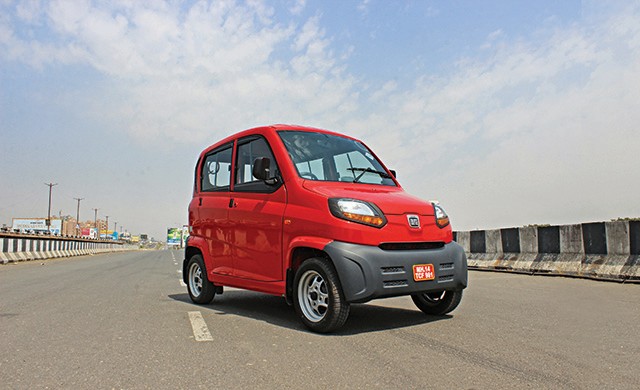
The Bajaj Qute is priced at Rs 2.48 lakh (ex-Pune) – it’s not a car, nor an auto but this unique looking four-wheeler is a Quadricycle. When one comes face to face with the Bajaj Qute, it looks like a car with the basics in place, but the design and proportions don’t suggest so. It only gets clearer when the Bajaj executives clarify that this isn’t a car but a quadricycle.
Background
To give you a quick backgrounder, the Bajaj Qute was unveiled during the Auto Expo of 2012 but it didn’t really take off because it was unable to clear all the safety requirements of a car. Obviously, it wasn’t meant to be one, but India did not have a category for this kind of a vehicle before. After a long-fought legal battle, the Indian government agreed to create a new segment. One can now buy a Qute for commercial purposes and Bajaj hope that people will also consider it for personal use.
[metaslider id=21920]
What’s a Quadricycle?
To put it broadly, a quadricycle is an ultra-compact four-wheeler with limited kerb weight and restricted top speed, one which can ply within city limits only. Highways are a strict no-no. The Bajaj fits all these criteria as it is less than three metres in length, measuring 2,750 millimetres; not wider than 1.5 metres at 1,312 mm, and has a limited top speed of 70 km/h. Essentially, it has all the virtues of a three-wheeler and tops it up with better weather protection and stability.
Who is it for?
Bajaj are positioning the Qute as an upgrade for auto-rickshaw owners and also for self-employed individuals who might use it for their city runabouts. Intrigued by the proposition, we drive India’s first-ever quadricycle to find out if it really is an attractive proposition to curb the urban commute blues.
Exterior Design
As we were puttering around the city people in cars, two-wheelers, and commercial vehicles slowed down to take a closer look at the Bajaj Qute. Its unusual demeanour sure made them inquisitive. The narrow width, the roof height of 1,652 mm, and puny 12-inch wheels give it an unwieldy appearance. The design is part utilitarian, part toy-car like, while the brilliant body colours like bright red or yellow attract a lot of attention. Something you may or may not like, but something you simply can’t ignore.
Based on a monocoque chassis, the basic structure like the pillars and roof is made of sheet metal. Plastic doors and bonnet have been employed to meet the weight limitation norm for a quadricycle. Bajaj assured that the plastic parts can be welded using 3M technology in case of damage caused in an accident. Being a rear-engined vehicle, there is a usable cavity under the bonnet with a capacity of 20 kg and because of the roof-rails, it can carry an additional 40 kg on top.





















Leave a Reply